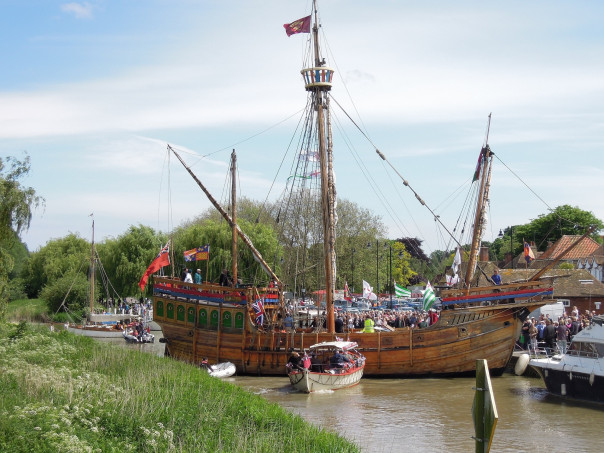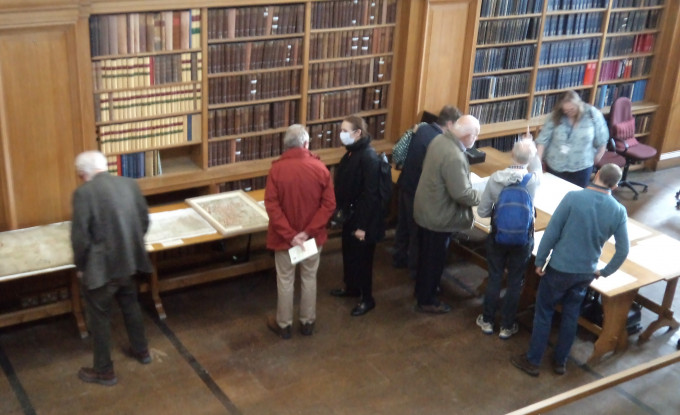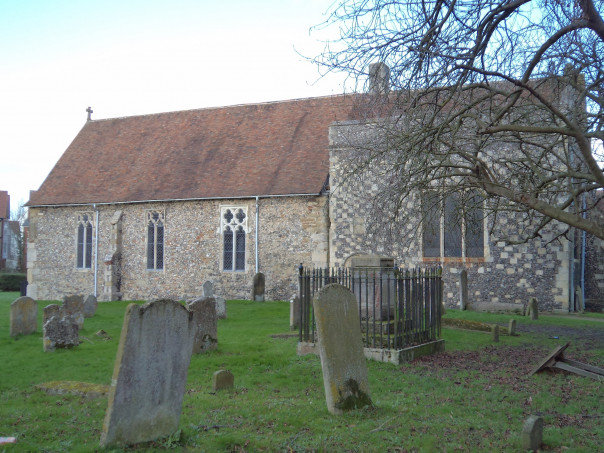Stop press! An update from yesterday, we have decided due to current conditions and the weather forecast for today to postpone Dr Catrinia Cooper’s FCAT/CKHH Lecture this evening. It will be rescheduled and I’ll let you know once it has been re-arranged. However, I am providing more details for the KAS Place-Names Group conference, and I want to bring to your attention an extra event that the CKHH has just arranged in November. Also, as a piece of information because I think it is worth mentioning the Canterbury City Council had been intending to sell the late medieval Sudbury Tower this week. This has been halted at least temporarily, but a new use for this important part of the city’s heritage is needed rather than it disappearing into private hands.

Firstly, at the Royal Engineers Museum, Gillingham, on Saturday 18th November between 10am and 4pm the KAS Place Names Group are holding a one-day conference with seven talks. As the publicity states “There is gentle focus this year on north-west Kent, with Paul Cullen speaking on the place-names of the Gillingham area, John Death the Anglo Saxon charter boundary of Meopham, and Nigel Price the Huguenot surnames of the Canterbury area. The other papers will range more broadly. Abigail Lloyd introduces her research using GIS to interpret Kentish hill-names. James Lloyd uses place-name evidence to suggest a location for the court of the lathe of Scray. Linda Taylor considers the famous 1598 map of Kent by Philip Symondson. Finally, in his second paper, Paul will detect some patterns and attempt to solve some puzzles in Kentish surnames.”
This promises to be an excellent day because as you can see there will be lots of exceedingly interesting speakers exploring a wide variety of names and naming practices. For £20 tickets, please see the QR code, and for further details, please see www.kentarchaeology.org.uk or facebook: @theKentArchaeologicalSociety1857 .

Now to our extra event, I am delighted to say Professor Alan Stewart, currently Visiting Professor at Queen Mary University of London before he returns at Christmas to Columbia University where he is Professor of English and Comparative Literature, will be coming to Canterbury on Tuesday 21 November to give a lecture entitled ‘The First Coming of the Strangers: An Experiment in Elizabethan Immigration’. This will be at 5pm and take place in the Michael Berry Lecture Theatre, Old Sessions House on the CCCU Canterbury campus. As Professor Stewart says, “In 1561, the town of Sandwich in Kent petitioned the Privy Council to allow a significant influx of immigrants to settle in their town, and practice their skills working with ‘says, bay and other clothe’—a model that was to spread across the south-east of England. Within six years, immigrants in Sandwich outnumbered the previous inhabitants, provoking a predictable backlash. While this immigration is often claimed as a masterstroke of state policy to introduce artisanal skills lacking in England, my paper explores it as a multi-faceted experiment, of importance not only to trade, but also to social relations, religion, education, and the period’s literature.” This is an exciting opportunity and as well as staff and students from CCCU, we will be welcoming the MEMS community from the University of Kent as well as members of the public to see Professor Stewart’s presentation. This is a free lecture; booking is not necessary and we shall look forward to welcoming you to what promises to be a fascinating talk.

As a consequence of this event, I thought I would see if there had been an influx of people from outside England arriving in Sandwich before the arrival of the Strangers. Relying on the data gathered by the team who undertook the AHRC-funded England’s Immigrants 1330–1550’ project [ https://www.englandsimmigrants.com/ ], it is interesting to note that for the first half of the 16th century, almost nobody is listed for Sandwich and by far and away the greatest number of aliens are listed under Canterbury where there were 98 of the 126 total. Having, therefore, switched my attention to Canterbury, I wanted to see, as I had done for the 15th-century city, whether it is possible to trace any of these immigrants as annual licenced artisans or traders and thus track their lives, even if only slightly, through the Canterbury records, especially those who seemingly remained as ‘intrantes’.
Not having had much time to investigate, I just have a few comments to make about five of these immigrants as a way of demonstrating the variety of experiences they had, although it is worth mentioning that none of the intrantes were labelled as aliens by Canterbury town clerk. From the national records, as you might expect, over half were said to be ‘Dutch’ with a handful of Scots (12), Flemings (7), French (6) and Germans (3). Almost all were male, and while ‘servant’ applied to the greatest number – 27, for the others very few occupations are mentioned. This is where bringing the local records to these national ones is especially useful and for all five, I have occupations.

Michael Abbey is my first example. According to the governmental records from April 1524, he was French and said to be living in the city’s Burgate. This accords with the intrantes records for in that year he paid the considerable licence fee of 3s4d as a member of Burgate ward where he worked as a smith. If the licence fee represents the measure of his success, this year seems to have been the high point of his activities because for the following two years he paid 2s 4d and then disappears from the records. He had apparently arrived in Burgate in 1519 as that is the first year the clerk recorded him as a smith, paying as he did in each of the subsequent three years the smaller sum of 12d.
Francis Brikilman, also of Burgate ward but listed as ‘Dutch’ was even less successful because he seemingly started as a mason in Canterbury on his own account in the middle of 1520 and thereafter over the next three years he only troubled the clerk twice, on both occasions paying 12d. He then disappears from the Canterbury records, perhaps having finished the contract he was working on and moving elsewhere to find further work.
In terms of longevity in Canterbury as an intrant, Garard Everson, another ‘Dutchman’ was far more successful having arrived (ie first paying) in 1512, although he may have been in Newingate ward in 1509. Either way, his business as a shoemaker seemingly prospered sufficiently that the fee charged by the clerk rose to 2s in 1513, staying at that rate until 1519 when it rose slightly to 2s 4d, and then again in 1523 to 2s 8d. After staying at this higher level for four yours, it dipped first to 2s 4d, then 2s before in his seemingly last year of 1531 it was back to 20d.

Another alien shoemaker who was even more successful was John Vanzele who apparently arrived in 1508 and set up business in Worthgate ward paying first 2s and then in 1512 and 1513 3s 4d. He continued to prosper, transferring his business to Newingate ward in 1515 and paying first 5s, this rising again in 1518 to the very large sum of 6s 8d. This would appear to have continued until 1523 and he was then able to become a freeman of Canterbury by redemption in 1524.
Another Dutchman who made the leap from intrant to freeman was Deryk Pope. As an intrant, he apparently began paying in 1523 and again the clerk expected a tidy sum of 2s 8d per year. After two years he moved to Burgate, but still paying the same sum and then he moved on again to Newingate, still at 2s 8d before in 1527 becoming a freeman of Canterbury. Albeit this is only impressionistic, it does suggest that Canterbury remained a destination people from continental Europe still saw as having potential in the early decades of the 16th century even though the city was experiencing some difficulties, especially in comparison to a century earlier.
Thus, although I have looked at just a few of these immigrants, the records still offer some interesting ideas and a more detailed picture of such men in 15th century Canterbury will be in the forthcoming essay collection edited by Dr Elizabeth Edwards and Professor David Killingray entitled Migration through the Ages in Kent, hopefully in 2024.
 Centre for Kent History and Heritage
Centre for Kent History and Heritage Sheila Sweetinburgh
Sheila Sweetinburgh 1881
1881

